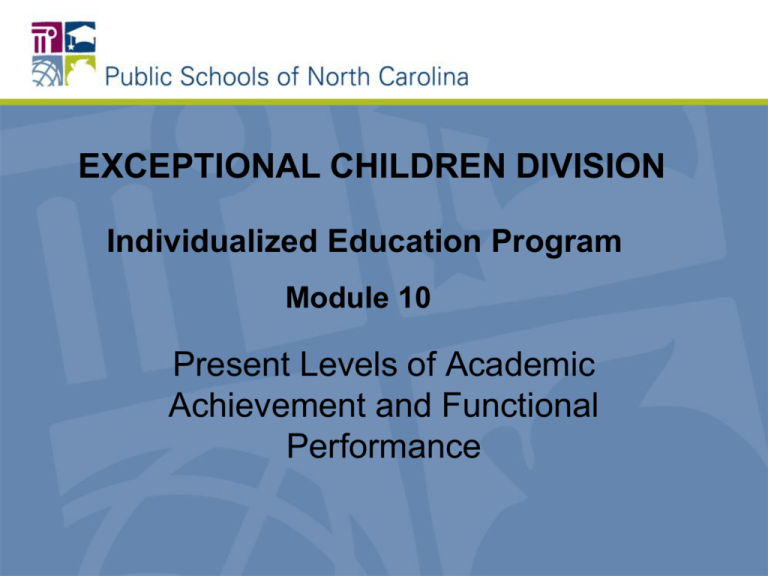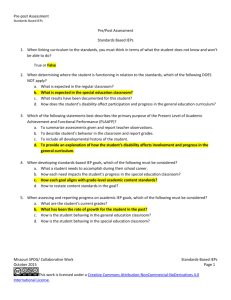PLAAFP_MODULE
advertisement

EXCEPTIONAL CHILDREN DIVISION Individualized Education Program Module 10 Present Levels of Academic Achievement and Functional Performance Module Objectives • Demonstrate knowledge of state/federal requirements regarding the development of the Present Level of Performance. • Identify components of the Present Level of Academic Achievement and Functional Performance. • Provide examples for the Present Level of Performance that address academic and functional skills. 2 Policy and Resource References • North Carolina Policies Governing Services for Children with Disabilities (November 1, 2007) •http://www.ncpublicschools.org/ec/ • Department of Education Federal Register (August 14, 2006) •http://idea.ed.gov 3 Individualized Education Program (a) General. As used in this part, the term individualized education program or IEP means a written statement for each child with a disability that is developed, reviewed, and revised in a meeting and that must include— NC 1503-4.1 4 Present Level of Academic Achievement and Functional Performance (PLAAFP) (1) A statement of the child’s present levels of academic achievement and functional performance, including— (i) How the child’s disability affects the child’s involvement and progress in the general education curriculum; or (ii) For preschool children, as appropriate, how the disability affects the child’s participation in appropriate activities;… 5 Academic Achievement • Academic achievement generally refers to a child’s performance in academic areas (e.g. reading, language arts, and math); or • For preschool children, age appropriate developmental levels. 6 Functional Performance • Functional performance generally refers to skills or activities that may not be considered academic or related to a child’s academic achievement. • Functional is often used in the context of routine activities of everyday living and are varied depending on the individual needs of the child. • Functional performance can impact educational achievement. 7 Present Levels of Performance Functional performance must be addressed for all students within the present levels of performance, and in the annual goals as appropriate. 8 The PLAAFP Must be… • Current • Relevant • Objective • Measurable • Understandable 9 Major Components of PLAAFP • Data-based student specific information related to current academic achievement and functional performance. • Strengths of the student. • Needs resulting from the disability. • Effects of the disability on involvement and progress in the general education curriculum. 10 Data-Based Student Specific Information Note: A variety of sources must be documented. • • Current and relevant formal evaluation data; and/or Current and relevant informal data: – Observations and supporting anecdotal records, – Work samples, – Progress toward last year’s goals, – Concerns of parents, – Student’s desired school/post-school outcome goals, and – Input from related services providers. 11 Data-Based Student Specific Information • Use objective measurable terms when writing the PLAAFP. • Data from the child’s evaluation is one source of such information. • Test scores that are pertinent to the child’s diagnosis might be included, if appropriate. • Scores should be self-explanatory. If not, an explanation must be included. 12 Data-Based Student Specific Information • The PLAAFPs are comprehensive for each skill area or domain (academic/functional). • Test scores must be explained. • The PLAAFPs should be jargon-free. 13 Strengths of the Student • Reflect specific skills or behaviors the student has mastered. • Reflect specific skills in which the student performs well for the domain or area targeted. 14 Needs Resulting from the Disability Needs are determined by consideration of… • The important skills and behaviors that are critical for the student to learn in order to be able to participate and make progress in the general curriculum. 15 Needs Resulting from the Disability Special factors: • Needs are addressed through goals, supports and services, and/or accommodations. 16 Effects of the Disability The PLAAFPs… • Describe how the disability impacts the student’s involvement in the general curriculum. • Convey the unique challenges or barriers that exist for the student as a result of the disability. • Describe the current levels of independence and any need for assistance. 17 Present Levels of Academic Achievement and Functional Performance Activity # 1 18 PLAAFP: Activity #1 Isabel Present Level of Academic Achievement and Functional Performance A review of informal checklist of social/emotional skills, indicates that Isabel is very social and loves to tease her friends in a playful way. When required to complete difficult tasks, Isabel often avoids these tasks by talking with her friends, and it often takes 5-10 verbal prompts to get Isabel to begin the task. Once she begins, she almost always completes the tasks. When she is tired she exhibits extreme emotions: uncontrollable giggling, sobbing, and occasional anger, approximately 5 times per week (according to parental and teacher report). This inhibits her progress in the general curriculum, as she needs direct instruction of social skills. 19 PLAAFP Component PLAAFP Statement 1. Data-based student specific information about the student’s current academic achievement and functional performance Informal checklist of social/emotional skills, parent and teacher report 2. Strengths of the student Very social, loves to tease kids in a playful way 3. Needs resulting from the disability Difficulty beginning tasks, demonstrates extreme emotions when tired 4. Effects of the disability on involvement and progress in the general education curriculum Inhibits progress in general curriculum, requires direct instruction 20 SAMANTHA Present Level of Academic Achievement and Functional Performance A review of speech/language anecdotal log of observations indicates that Sam speaks using words and phrases. She doesn’t use complete sentences or questions when speaking. She initiates and responds to greetings appropriately. She doesn’t verbally express herself to gain others attention. Instead she grabs others and/or their clothing (e.g. hats, jackets) to initiate conversation or join in a group. These skill deficits affect her ability to communicate within the general education setting and develop appropriate social skills. 21 PLAAFP Component 1. Data-based student specific information about the student’s current academic achievement and functional performance PLAAFP Statement Anecdotal log of observations 2. Strengths of the student Speaks using words and phrases, initiates and responds to greetings 3. Needs resulting from the disability Uses sentences and phrases when speaking to initiate conversation 4. Effects of the disability on involvement and progress in the general education curriculum Communication in the general education setting and social skill development 22 Anthony Present Level of Academic Achievement and Functional Performance A review of curriculum-based measures indicates that Anthony, a fourth grade student, can read 80 words per minute of connected text with 100% accuracy, which is within the range of words per minute established for typical peers in the second grade. Anthony demonstrates a relative strength in determining the meaning of unknown words by reading words in context and applying word structures (prefix, base words, suffix). Anthony’s limited attention span and distractibility can detract him from completing assigned tasks, focusing on the details of reading passages/assignments and remaining on task. 23 PLAAFP Component 1. Data-based student specific information about the student’s current academic achievement and functional performance 2. Strengths of the student PLAAFP Statement Curriculum-based measures Determines the meaning of unknown words by reading words in context and applying word structures 3. Needs resulting from the disability Reading fluently for comprehension 4. Effects of the disability on involvement and progress in the general education curriculum Limited attention span impacts ability to focus on the details of reading passages & completing assignments 24 Herbie Present Level of Academic Achievement and Functional Performance Based upon informal classroom math assessment, Herbie can count to 50, count objects to 50, recognize and write numerals 0-9, and group objects in sets. He recognizes a line, square, and circle, but not a rectangle or triangle. He cannot add or subtract 2 digit by 1 digit problems without regrouping. These skill deficits impact his ability to apply his knowledge to the third grade curriculum. 25 PLAAFP Component 1. Data-based student specific information about the student’s current academic achievement and functional performance 2. Strengths of the student 3. Needs resulting from the disability 4. Effects of the disability on involvement and progress in the general education curriculum PLAAFP Statement Informal classroom math assessment Counts to 50, recognizes and writes numerals 0-9, groups objects in sets, recognizes basic shapes Adds and subtracts 2 digit numbers without regrouping, Identifies rectangle and triangle Affects his ability to apply math knowledge to the 3rd grade curriculum 26 Jack Present Level of Academic Achievement and Functional Performance Based on informal teacher assessment and review of observations from anecdotal record, Jack can sort one dollar bills, up to four dollars. Jack is unable to make coin combinations to equal one dollar. This affects his ability to calculate and problem solve in the general curriculum as well as in daily life skill activities. 27 PLAAFP Component PLAAFP Statement 1. Data-based student specific information about the student’s current academic achievement and functional performance Informal teacher assessment, review of observations from anecdotal record 2. Strengths of the student Sorts one dollar bills, up to four dollars 3. Needs resulting from the disability 4. Effects of the disability on involvement and progress in the general education curriculum Combines coins to make one dollar Affects his ability to calculate and problem solve in the general curriculum as well as in daily life skill activities. 28 Amelia Present Level of Academic Achievement and Functional Performance Amelia engages in leisure activities by herself for up to 30 minutes based on a daily log of observations. She does not initiate play with her peers, and only plays alongside others when they have toys that are interesting to her. She often takes those toys rather than ask for a turn (on average 4 times per day). Amelia’s social skills interfere with her educational performance and development of relationships to work and play cooperatively with others. 29 PLAAFP Component PLAAFP Statement 1. Data-based student specific information about the student’s current academic achievement and functional performance Daily log of observations 2. Strengths of the student Engages in leisure activities by herself for up to 30 minutes 3. Needs resulting from the disability Initiates/joins in leisure activities with other children appropriately 4. Effects of the disability on involvement and progress in the general education curriculum Social skills interfere with her educational performance and development of relationships to work and play cooperatively with others. 30 Oliver Present Level of Academic Achievement and Functional Performance According to a log of teacher observations/anecdotal records, Oliver continues to struggle to create a product about a personal event as it relates to text (Competency 8.1). He has improved his recall of personal events. He has worked on creating text about his personal experience by assembling photo journals of events he has participated in. He currently is able to then add one or two words to describe the remnant or photo. Relating those events to a text is frustrating for Oliver in the general curriculum because it is hard for him to make comparisons. 31 PLAAFP Component 1. Data-based student specific information about the student’s current academic achievement and functional performance 2. Strengths of the student PLAAFP Statement Log of teacher observations and anecdotal records Recalls personal events 3. Needs resulting from the disability Creating text using descriptive words 4. Effects of the disability on involvement and progress in the general education curriculum Affects ability to make comparisons creating frustrations in the general curriculum 32 Present Level of Academic Achievement and Functional Performance BOTTOM LINE……… The present level of performance is the cornerstone of the IEP. It is the source that drives other IEP components. It is the statement that links all components of the IEP together. 33






